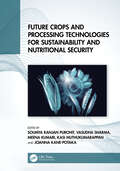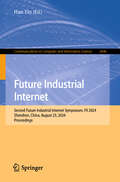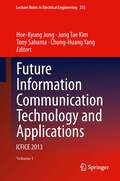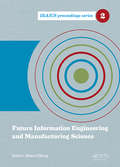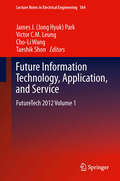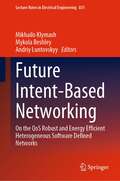- Table View
- List View
Future Crimes
by Marc GoodmanOne of the world's leading authorities on global security, Marc Goodman takes readers deep into the digital underground to expose the alarming ways criminals, corporations, and even countries are using new and emerging technologies against you--and how this makes everyone more vulnerable than ever imagined. Technological advances have benefited our world in immeasurable ways, but there is an ominous flip side: our technology can be turned against us. Hackers can activate baby monitors to spy on families, thieves are analyzing social media posts to plot home invasions, and stalkers are exploiting the GPS on smart phones to track their victims' every move. We all know today's criminals can steal identities, drain online bank accounts, and wipe out computer servers, but that's just the beginning. To date, no computer has been created that could not be hacked--a sobering fact given our radical dependence on these machines for everything from our nation's power grid to air traffic control to financial services. Yet, as ubiquitous as technology seems today, just over the horizon is a tidal wave of scientific progress that will leave our heads spinning. If today's Internet is the size of a golf ball, tomorrow's will be the size of the sun. Welcome to the Internet of Things, a living, breathing, global information grid where every physical object will be online. But with greater connections come greater risks. Implantable medical devices such as pacemakers can be hacked to deliver a lethal jolt of electricity and a car's brakes can be disabled at high speed from miles away. Meanwhile, 3-D printers can produce AK-47s, bioterrorists can download the recipe for Spanish flu, and cartels are using fleets of drones to ferry drugs across borders. With explosive insights based upon a career in law enforcement and counterterrorism, Marc Goodman takes readers on a vivid journey through the darkest recesses of the Internet. Reading like science fiction, but based in science fact, Future Crimes explores how bad actors are primed to hijack the technologies of tomorrow, including robotics, synthetic biology, nanotechnology, virtual reality, and artificial intelligence. These fields hold the power to create a world of unprecedented abundance and prosperity. But the technological bedrock upon which we are building our common future is deeply unstable and, like a house of cards, can come crashing down at any moment. Future Crimes provides a mind-blowing glimpse into the dark side of technological innovation and the unintended consequences of our connected world. Goodman offers a way out with clear steps we must take to survive the progress unfolding before us. Provocative, thrilling, and ultimately empowering, Future Crimes will serve as an urgent call to action that shows how we can take back control over our own devices and harness technology's tremendous power for the betterment of humanity--before it's too late.From the Hardcover edition.
Future Crimes
by Marc GoodmanNEW YORK TIMES and WALL STREET JOURNAL BESTSELLER ONE OF THE WASHINGTON POST'S 10 BEST BOOKS OF 2015One of the world's leading authorities on global security, Marc Goodman takes readers deep into the digital underground to expose the alarming ways criminals, corporations, and even countries are using new and emerging technologies against you--and how this makes everyone more vulnerable than ever imagined. Technological advances have benefited our world in immeasurable ways, but there is an ominous flip side: our technology can be turned against us. Hackers can activate baby monitors to spy on families, thieves are analyzing social media posts to plot home invasions, and stalkers are exploiting the GPS on smart phones to track their victims' every move. We all know today's criminals can steal identities, drain online bank accounts, and wipe out computer servers, but that's just the beginning. To date, no computer has been created that could not be hacked--a sobering fact given our radical dependence on these machines for everything from our nation's power grid to air traffic control to financial services. Yet, as ubiquitous as technology seems today, just over the horizon is a tidal wave of scientific progress that will leave our heads spinning. If today's Internet is the size of a golf ball, tomorrow's will be the size of the sun. Welcome to the Internet of Things, a living, breathing, global information grid where every physical object will be online. But with greater connections come greater risks. Implantable medical devices such as pacemakers can be hacked to deliver a lethal jolt of electricity and a car's brakes can be disabled at high speed from miles away. Meanwhile, 3-D printers can produce AK-47s, bioterrorists can download the recipe for Spanish flu, and cartels are using fleets of drones to ferry drugs across borders. With explosive insights based upon a career in law enforcement and counterterrorism, Marc Goodman takes readers on a vivid journey through the darkest recesses of the Internet. Reading like science fiction, but based in science fact, Future Crimes explores how bad actors are primed to hijack the technologies of tomorrow, including robotics, synthetic biology, nanotechnology, virtual reality, and artificial intelligence. These fields hold the power to create a world of unprecedented abundance and prosperity. But the technological bedrock upon which we are building our common future is deeply unstable and, like a house of cards, can come crashing down at any moment. Future Crimes provides a mind-blowing glimpse into the dark side of technological innovation and the unintended consequences of our connected world. Goodman offers a way out with clear steps we must take to survive the progress unfolding before us. Provocative, thrilling, and ultimately empowering, Future Crimes will serve as an urgent call to action that shows how we can take back control over our own devices and harness technology's tremendous power for the betterment of humanity--before it's too late.From the Hardcover edition.
Future Crops and Processing Technologies for Sustainability and Nutritional Security
by Vasudha Sharma Soumya Ranjan Purohit Meena Kumari Kasi Muthukumarappan Joanna Kane-PotakaOur current food system faces challenges across the board – from ensuring food security and reducing environmental impact to managing costs and minimizing waste. Fortunately, cutting-edge food processing technologies play a critical role in paving the way for a more sustainable future. Taking a two-track approach, Future Crops and Processing Technologies for Sustainability and Nutritional Security presents sustainable technologies and emerging crops that are capable of ensuring nutritional security. There are various crops that are nutritious but under-utilized. Crops covered in the book are those that are climate resilient and exhibit less use of water and zero discharge to environment, such as millets and legumes like chickpea, groundnuts, and pigeon pea.KEY FEATURES: Provides a comprehensive literature review on the opportunities and challenges in achieving sustainability and nutritional security Presents compatible, relevant crops to address both sustainability and nutritional security Discusses the emerging technologies/crops/food products to justify sustainability and potential to ensure nutritional security This book also provides information on all aspects related to the processing and use of sustainable technologies and crops. The use of technologies like 3D printing, novel drying method, high pressure processing, high-voltage treatments, and the proper combination of conventional methods are addressed.
Future Data and Security Engineering. Big Data, Security and Privacy, Smart City and Industry 4.0 Applications: 10th International Conference, FDSE 2023, Da Nang, Vietnam, November 22–24, 2023, Proceedings (Communications in Computer and Information Science #1925)
by Josef Küng Tran Khanh Dang Tai M. ChungThis book constitutes the proceedings of the 10th International Conference on Future Data and Security Engineering. Big Data, Security and Privacy, Smart City and Industry 4.0 Applications, FDSE 2023, held in Da Nang, Vietnam, during November 22–24, 2023.The 38 full papers and 8 short papers were carefully reviewed and selected from 135 submissions. They were organized in topical sections as follows: big data analytics and distributed systems; security and privacy engineering; machine learning and artificial intelligence for security and privacy; smart city and industry 4.0 applications; data analytics and healthcare systems; and short papers: security and data engineering.
Future Data and Security Engineering. Big Data, Security and Privacy, Smart City and Industry 4.0 Applications: 11th International Conference on Future Data and Security Engineering, FDSE 2024, Binh Duong, Vietnam, November 27–29, 2024, Proceedings, Part I (Communications in Computer and Information Science #2309)
by Josef Küng Tran Khanh Dang Tai M. ChungThis two-volume set CCIS 2309-2310 constitutes the refereed proceedings of the 11th International Conference on Future Data and Security Engineering. Big Data, Security and Privacy, Smart City and Industry 4.0 Applications, FDSE 2024, held in Binh Duong, Vietnam, during November 27–29, 2024. The 44 full papers, 12 short papers and 1 keynote paper were carefully reviewed and selected from 189 submissions. They were organized in topical sections as follows: advances in machine learning for big data analytics; security and privacy engineering; data analytics and healthcare systems; smart city and industry 4.0 applications; big data query processing and optimization; and short papers; security and data engineering.
Future Data and Security Engineering. Big Data, Security and Privacy, Smart City and Industry 4.0 Applications: 11th International Conference on Future Data and Security Engineering, FDSE 2024, Binh Duong, Vietnam, November 27–29, 2024, Proceedings, Part II (Communications in Computer and Information Science #2310)
by Josef Küng Tran Khanh Dang Tai M. ChungThis two-volume set CCIS 2309-2310 constitutes the refereed proceedings of the 11th International Conference on Future Data and Security Engineering. Big Data, Security and Privacy, Smart City and Industry 4.0 Applications, FDSE 2024, held in Binh Duong, Vietnam, during November 27–29, 2024. The 44 full papers, 12 short papers and 1 keynote paper were carefully reviewed and selected from 189 submissions. They were organized in topical sections as follows: advances in machine learning for big data analytics; security and privacy engineering; data analytics and healthcare systems; smart city and industry 4.0 applications; big data query processing and optimization; and short papers; security and data engineering.
Future Data and Security Engineering. Big Data, Security and Privacy, Smart City and Industry 4.0 Applications: 8th International Conference, FDSE 2021, Virtual Event, November 24–26, 2021, Proceedings (Communications in Computer and Information Science #1500)
by Josef Küng Tran Khanh Dang Makoto Takizawa Tai M. ChungThis book constitutes the proceedings of the 8th International Conference on Future Data and Security Engineering, FDSE 2021, held in Ho Chi Minh City, Vietnam, in November 2021.*The 28 full papers and 8 short were carefully reviewed and selected from 168 submissions. The selected papers are organized into the following topical headings: big data analytics and distributed systems; security and privacy engineering; industry 4.0 and smart city: data analytics and security; blockchain and access control; data analytics and healthcare systems; and short papers: security and data engineering.* The conference was held virtually due to the COVID-19 pandemic.
Future Data and Security Engineering. Big Data, Security and Privacy, Smart City and Industry 4.0 Applications: 9th International Conference, FDSE 2022, Ho Chi Minh City, Vietnam, November 23–25, 2022, Proceedings (Communications in Computer and Information Science #1688)
by Josef Küng Tran Khanh Dang Tai M. ChungThis book constitutes the refereed proceedings of the 9th International Conference on Future Data and Security Engineering, FDSE 2022, held in Ho Chi Minh City, Vietnam, during November 23–25, 2022. The 41 full papers(including 4 invited keynotes) and 12 short papers included in this book were carefully reviewed and selected from 170 submissions. They were organized in topical sections as follows: invited keynotes; big data analytics and distributed systems; security and privacy engineering; machine learning and artificial intelligence for security and privacy; smart city and industry 4.0 applications; data analytics and healthcare systems; and security and data engineering.
Future Data and Security Engineering: 8th International Conference, FDSE 2021, Virtual Event, November 24–26, 2021, Proceedings (Lecture Notes in Computer Science #13076)
by Josef Küng Tran Khanh Dang Makoto Takizawa Tai M. ChungThis book constitutes the proceedings of the 8th International Conference on Future Data and Security Engineering, FDSE 2021, which was supposed to be held in Ho Chi Minh City, Vietnam, in November 2021, but the conference was held virtually due to the COVID-19 pandemic. The 24 full papers presented together with 2 invited keynotes were carefully reviewed and selected from 168 submissions. The selected papers are organized into the following topical headings: Big Data Analytics and Distributed Systems; Advances in Machine Learning for Big Data Analytics; Industry 4.0 and Smart City: Data Analytics and Security; Blockchain and IoT Applications; Machine Learning and Artificial Intelligence for Security and Privacy; Emerging Data Management Systems and Applications.
Future Directions in Energy Engineering: Challenges, Opportunities, and Sustainability (Green Energy and Technology)
by Xiaolin WangFuture Directions in Energy Engineering: Challenges, Opportunities, and Sustainability presents new advances and research results in theoretical, experimental, and practical sustainable energy engineering. Contributions cover case studies to explore and analyze technological advancements alongside practical applications to help readers better understand the relevant concepts and solutions necessary to achieve clean energy and sustainable development. The book brings together the latest developments in the emerging areas of intelligent power systems, green energy, and technology. Coverage includes: Electric power generation, transmission, and distribution; Power system economics, operation, and control; Energy storage and cybersecurity for smart grids; Energy efficiency in building designs and management; Sustainable materials for buildings; Integration of renewable energy sources in buildings; Greening urbanization and urban settlements. The book offers approaches to help engineers and researchers in sustainable energy engineering technologies solve practical problems affecting their daily work.
Future Drive: Electric Vehicles And Sustainable Transportation
by Daniel Sperling A. F. Burke Patricia M. Davis Mark A. DelucchiIn Future Drive, Daniel Sperling addresses the adverse energy and environmental consequences of increased travel, and analyzes current initiatives to suggest strategies for creating a more environmentally benign system of transportation. Groundbreaking proposals are constructed around the idea of electric propulsion as the key to a sustainable transportation and energy system. Other essential elements include the ideas that: *improving technology holds more promise than large-scale behavior modification *technology initiatives must be matched with regulatory and policy initiatives *government intervention should be flexible and incentive-based, but should also embrace selective technology-forcing measures *more diversity and experimentation is needed with regard to vehicles and energy technologies Sperling evaluates past and current attempts to influence drivers and vehicle use, and articulates a clear and compelling vision of the future. He formulates a coherent and specific set of principles, strategies, and policies for redirecting the United States and other countries onto a new sustainable pathway.
Future Energy: Challenge, Opportunity, and, Sustainability (Green Energy and Technology)
by Xiaolin WangFuture Energy: Challenge, Opportunity, and Sustainability presents new advances and research results in the fields of theoretical, experimental, and practical sustainable energy engineering. The book’s chapters are based on selected research papers presented at the 2023 7th International Conference on Sustainable Energy Engineering (ICSEE 2023). Contributions cover case studies to explore and analyze technological advancements alongside practical applications to help readers better understand the relevant concepts and solutions necessary to achieve clean energy and sustainable development. The book brings together the latest developments in the emerging areas of intelligent power systems, green energy, and technology. It offers approaches to help engineers and researchers working in sustainable energy engineering technologies solve practical problems affecting their daily work.
Future Fear: Fear of the Future from Prehistory to Climate Change
by John PottsThis book places the contemporary fear of climate change in historical perspective, showing that throughout human history the dominant perspective on the future has been one of fear. Across a broad historical sweep, the book describes the varied means employed to predict and control the future: magic, religion, science, and technology. Future Fear traces fear of the future from prehistory to the present, culminating in the contemporary fear of imminent climate change catastrophe. Consideration is also given to hope in a more positive future, revealing that visions of the future have often been a mingling of fear and hope.
Future Fixed and Mobile Broadband Internet, Clouds, and IoT/AI
by Toni JanevskiFUTURE FIXED AND MOBILE BROADBAND INTERNET, CLOUDS, AND IoT/AI All-in-one resource on the development of Internet and telecoms worldwide, based on the technological frameworks as defined by the ITU Future Fixed and Mobile Broadband Internet, Clouds, and IoT/AI is a highly comprehensive resource that provides full coverage of existing and future fixed and mobile broadband networks, internet, and telecom and OTT services. This book explains how to perform technical, business, and regulatory analysis for future 5G-Advanced, 6G, WiFi, and optical access. This book also covers optical transport, submarine cable, future satellite broadband, cloud computing, massive and critical IoT and frameworks and use of AI / ML in telecommunications. Topics covered include: Internet technologies, IPv6, QUIC, DNS, IPX, QoS in Internet/IP, cybersecurity, future Internet 2030, Internet governance Future metallic and optical broadband, carrier-grade Ethernet, SD-WAN, OTN, submarine cable, satellite broadband, business and regulation of broadband Future mobile and wireless broadband, 5G-Advanced, 5G/6G spectrum management, 5G Non-Terrestrial Networks, QoS, 6G/IMT-2030, WiFi 7 (802.11.be), mobile business and regulatory aspects Cloud computing architectures and service models, MLaaS, BaaS, future OTT and telecom cloud services, business and regulation of clouds Future voice, future TV, XR/AR/VR, critical IoT/AI services, future OTT services, metaverse, network neutrality, future digital economy and markets Future Fixed and Mobile Broadband Internet, Clouds, and IoT/AI is an essential reference for government officials and regulators, business leaders, engineers, managers, and employees in the telecommunications industry, ICT business professionals, and students in telecommunications.
Future Health Scenarios: AI and Digital Technologies in Global Healthcare Systems (Advances in Smart Healthcare Technologies)
by Chinmay Chakraborty Maria José Sousa Francisco Guilherme Nunes Generosa Do NascimentoDigital technologies is a major emerging area to invest and research in new models of health management. Future health scenarios are constituted by technologies in health and clinical decision-making systems. This book provides a unique multidisciplinary approach for exploring the potential contribution of AI and digital technologies in enabling global healthcare systems to respond to urgent twenty-first-century challenges. Deep analysis has been made regarding telemedicine using big data, deep learning, robotics, mobile and remote applications. Features: Focuses on prospective scenarios in health to predict possible futures. Addresses the urgent needs of the key population, socio-technical and health themes. Covers health innovative practices as 3D models for surgeries, big data to treat rare diseases, and AI robot for heart treatments. Explores telemedicine using big data, deep learning, robotics, mobile and remote applications. Reviews public health based on predictive analytics and disease trends. This book is aimed at researchers, professionals, and graduate students in computer science, artificial intelligence, decision support, healthcare technology management, biomedical engineering, and robotics.
Future Histories: What Ada Lovelace, Tom Paine, and the Paris Commune Can Teach Us About Digital Technology
by Lizzie O'SheaA highly engaging tour through progressive history in the service of emancipating our digital tomorrow.When we talk about technology we always talk about tomorrow and the future -- which makes it hard to figure out how to even get there. In Future Histories, public interest lawyer and digital specialist Lizzie O'Shea argues that we need to stop looking forward and start looking backwards. Weaving together histories of computing and progressive social movements with modern theories of the mind, society, and self, O'Shea constructs a "usable past" that can help us determine our digital future.What, she asks, can the Paris Commune tell us about earlier experiments in sharing resources--like the Internet--in common? How can Frantz Fanon's theories of anti colonial self-determination help us build digital world in which everyone can participate equally? Can debates over equal digital access be helped by American revolutionary Tom Paine's theories of democratic, economic redistribution? What can indigenous land struggles teach us about stewarding our digital climate? And, how is Elon Musk not a future visionary but a steampunk throwback to Victorian-era technological utopians?In engaging, sparkling prose, O'Shea shows us how very human our understanding of technology is, and how when we draw on the resources of the past, we can see the potential for struggle, for liberation, for art and poetry in our technological present. Future Histories is for all of us--makers, coders, hacktivists, Facebook-users, self-styled Luddites--who find ourselves in a brave new world.
Future Horizons: Canadian Digital Humanities (Canadian Literature Collection)
by Susan Brown Gregory Betts Dean Irvine Sandra Djwa Constance Crompton Katherine McLeod Klara Du Plessis Kiera Obbard Roopika Risam Andrea Zeffiro Deanna Fong M Ryan Fitzpatrick M Eric Schmaltz Dani Spinosa M David Gaertner M Mark V. Campbell M Jon Saklofske Julia Polyck-O’Neill Kim Martin Rashmeet Kaur Pascale Dangoisse Michelle Schwartz Graham H. Jensen M Allan Cho Sarah Zhang Kendra Cowley Asen IvanovAu fil des vingt et quelques chapitres que compte cet ouvrage, les auteurs explorent le passé, le présent et l’avenir de la recherche, de l’enseignement et de l’expérimentation en sciences humaines numériques au Canada. Ce recueil, qui rassemble les travaux de chercheuses et de chercheurs établis et émergents, présente des initiatives contemporaines dans le domaine des sciences humaines numériques. Celles-ci sont conjuguées à un réexamen de l’héritage légué par ce domaine jusqu’à ce jour et à des discussions sur son potentiel. Future Horizons jette aussi un regard historique sur des projets numériques d’envergure, quoique largement méconnus, qui ont été réalisés au Canada. Future Horizons fait plonger le lecteur dans des projets qui mettent à contribution une vaste gamme d’approches — des jeux numériques aux laboratoires ouverts, des archives sonores à la poésie numérique, des arts visuels à l’analyse textuelle numérique — et qui puisent dans des matériaux canadiens tant historiques que contemporains. Dans leurs essais, les auteurs font voir comment une telle diversité d’approches remet en cause la connaissance en permettant aux chercheurs de poser de nouvelles questions.Ce recueil remet en question l’idée selon laquelle il n’existerait qu’une seule définition des sciences humaines numériques ou une seule identité collective nationale. En observant les interactions du numérique avec la race, l’autochtonie, le genre et la sexualité — sans oublier l’histoire, la poésie et le concept de nation —, Future Horizons propose une vue élargie du travail à l’intersection des sciences humaines numériques et des sciences humaines traditionnelles dans le Canada d’aujourd’hui. Ce livre est publié en anglais.Formats disponibles : couverture souple, PDF accessible et ePub accessible.
Future Hype: The Myths of Technology Change
by Bob SeidenstickerConventional wisdom says that technology is the greatest new growth frontier, coupling infinite potential with an ever-growing number of faster, more efficient, and more reliable products and instruments.According to this view, we live in an unprecedented golden age of technological expansion. Not so, according to Future Hype.
Future Industrial Internet: Second Future Industrial Internet Symposium, FII 2024, Shenzhen, China, August 23, 2024, Proceedings (Communications in Computer and Information Science #2446)
by Hao YinThis book constitutes the proceedings of the Second Future Industrial Internet Symposium, FII 2024, held in Shenzhen, China, on August 23, 2024. The 12 full papers and 4 short papers presented in this book were carefully reviewed and selected from 75 submissions.They focus on verious aspects of the latest research, applications and development trends related to the industrial internet and associated fields.
Future Information Communication Technology and Applications: ICFICE 2013
by Chung-Huang Yang Hoe-Kyung Jung Jung Tae Kim Tony SahamaThese proceedings are based on the 2013 International Conference on Future Information & Communication Engineering (ICFICE 2013), which will be held at Shenyang in China from June 24-26, 2013. The conference is open to all over the world, and participation from Asia-Pacific region is particularly encouraged. The focus of this conference is on all technical aspects of electronics, information, and communications ICFICE-13 will provide an opportunity for academic and industry professionals to discuss the latest issues and progress in the area of FICE. In addition, the conference will publish high quality papers which are closely related to the various theories and practical applications in FICE. Furthermore, we expect that the conference and its publications will be a trigger for further related research and technology improvements in this important subject.
Future Information Engineering and Manufacturing Science: Proceedings of the 2014 International Conference on Future Information Engineering and Manufacturing Science (FIEMS 2014), June 26-27, 2014, Beijing, China (IRAICS Proceedings)
by Dawei ZhengThe 2014 International Conference on Future Information Engineering and Manufacturing Science (FIEMS 2014) was held June 26-27 in Beijing, China. The objective of FIEMS 2014 was to provide a platform for researchers, engineers, academics as well as industry professionals from all over the world to present their research results and development acti
Future Information Technology, Application, and Service
by Victor C.M. Leung Taeshik Shon James Jong Park Cho-Li WangThis book is proceedings of the 7th FTRA International Conference on Future Information Technology (FutureTech 2012). The topics of FutureTech 2012 cover the current hot topics satisfying the world-wide ever-changing needs. The FutureTech 2012 is intended to foster the dissemination of state-of-the-art research in all future IT areas, including their models, services, and novel applications associated with their utilization. The FutureTech 2012 will provide an opportunity for academic and industry professionals to discuss the latest issues and progress in this area. In addition, the conference will publish high quality papers which are closely related to the various theories, modeling, and practical applications in many types of future technology. The main scope of FutureTech 2012 is as follows. Hybrid Information Technology Cloud and Cluster Computing Ubiquitous Networks and Wireless Communications Multimedia Convergence Intelligent and Pervasive Applications Security and Trust Computing IT Management and Service Bioinformatics and Bio-Inspired Computing Database and Data Mining Knowledge System and Intelligent Agent Human-centric Computing and Social Networks The FutureTech is a major forum for scientists, engineers, and practitioners throughout the world to present the latest research, results, ideas, developments and applications in all areas of future technologies.
Future Intelligent Vehicular Technologies
by Muhammad Alam Joaquim FerreiraThis book constitutes the refereed proceedings of the First International Conference on Future Intelligent Vehicular Technologies, Future 5V 2016, held in Porto, Portugal, in September 2016. Future 5V presents vehicular networks and communications and also hosted the "Internet of Things (IoT) meets Big Data and Cloud Computing Workshop". The 21 revised full papers presented were reviewed and selected from 38 submissions. The papers cover all aspects of intelligent vehicular communications including security and applications.
Future Intelligent Vehicular Technologies: First International Conference, Future 5V 2016, Porto, Portugal, September 15, 2016, Revised Selected Papers (Lecture Notes of the Institute for Computer Sciences, Social Informatics and Telecommunications Engineering #185)
by Muhammad Alam Joaquim FerreiraThis book constitutes the refereed proceedings of the First International Conference on Future Intelligent Vehicular Technologies, Future 5V 2016, held in Porto, Portugal, in September 2016. Future 5V presents vehicular networks and communications and also hosted the “Internet of Things (IoT) meets Big Data and Cloud Computing Workshop”. The 21 revised full papers presented were reviewed and selected from 38 submissions. The papers cover all aspects of intelligent vehicular communications including security and applications.
Future Intent-Based Networking: On the QoS Robust and Energy Efficient Heterogeneous Software Defined Networks (Lecture Notes in Electrical Engineering #831)
by Andriy Luntovskyy Mikhailo Klymash Mykola BeshleySo-called Intent-Based Networking (IBN) is founded on well-known SDN (Software-Defined Networking) and represents one of the most important emerging network infrastructure opportunities. The IBN is the beginning of a new era in the history of networking, where the network itself translates business intentions into appropriate network configurations for all devices. This minimizes manual effort, provides an additional layer of network monitoring, and provides the ability to perform network analytics and take full advantage of machine learning. The centralized, software-defined solution provides process automation and proactive problem solving as well as centralized management of the network infrastructure. With software-based network management, many operations can be performed automatically using intelligent control algorithms (artificial intelligence and machine learning). As a result, network operation costs, application response times and energy consumption are reduced, network reliability and performance are improved, network security and flexibility are enhanced. This will be a benefit for existing networks as well as evolved LTE-based mobile networks, emerging Internet of Things (IoT), Cloud systems, and soon for the future 5G/6G networks. The future networks will reach a whole new level of self-awareness, self-configuration, self-optimization, self-recovery and self-protection.This volume consists of 28 chapters, based on recent research on IBN.The volume is a collection of the most important research for the future intent-based networking deployment provided by different groups of researchers from Ukraine, Germany, Slovak Republic, Switzerland, South Korea, China, Czech Republic, Poland, Brazil, Belarus and Israel. The authors of the chapters from this collection present in depth extended research results in their scientific fields.The presented contents are highly interesting while still being rather practically oriented and straightforward to understand. Herewith we would like to wish all our readers a lot of inspiration by studying of the volume!

